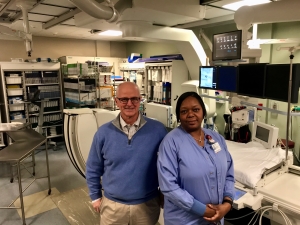 Fibroids are benign (non-cancerous) tumors in the uterus that do not spread
to other parts of the body. It is estimated that half of all women will
suffer from fibroids by the age of 50.
Fibroids are benign (non-cancerous) tumors in the uterus that do not spread
to other parts of the body. It is estimated that half of all women will
suffer from fibroids by the age of 50.
Angela Cheek is our nurse manager for heart and vascular services at Catawba
Valley Medical Center. In her late 30’s, fibroids were making her
extremely uncomfortable, unusually fatigued and they were painful certain
times of the month. Heavy bleeding during menstruation caused her to become
anemic and was interfering with her lifestyle. She also was bothered by
an increase in her abdominal girth. This went on for about two years with
no relief.
"After an ultrasound confirmed the diagnosis of uterine fibroids,
I had a discussion with Dr. Bools, an interventional radiologist here
at Catawba Valley Medical Center,” says Angela. “We discussed
Uterine Fibroid Embolization (UFE) and I was ecstatic to learn that I
was a good candidate for this procedure.”
The first UFE procedure in the United States was completed in 1996. Since
then, there has been a rapid spread in the procedure in the U.S. and worldwide
as a treatment option for fibroids.
Dr. Bools says, “UFE is a minimally invasive, highly effective, non-surgical
treatment for fibroids where we insert a thin catheter into an artery
under moderate sedation in the hospital’s radiology suite. The catheter
is then guided to the fibroid's blood supply where small particles,
about the size of grains of sand, are released to block the blood vessels
feeding the fibroid, depriving it of nutrients. As a result, the fibroid
shrinks and dies. After treatment, women should be back to their normal
activities in about a week. While it’s not the right option for
all patients, I’m glad that we could help Angela.”
“It was incredible,” says Angela. “I had UFE on a Friday
and was back to work on Monday. I feel like I got my life back. There
was only a tiny incision and no scarring. My heavy periods stopped and
- within 6 months - my abdominal girth returned to normal. Even 10 years
ago, this procedure wouldn’t have been an option for me at CVMC.
I share this story because as a nurse and a patient, I’m excited
to see how advances in medicine are changing the face of women’s
health and providing us with new treatment options every day.”